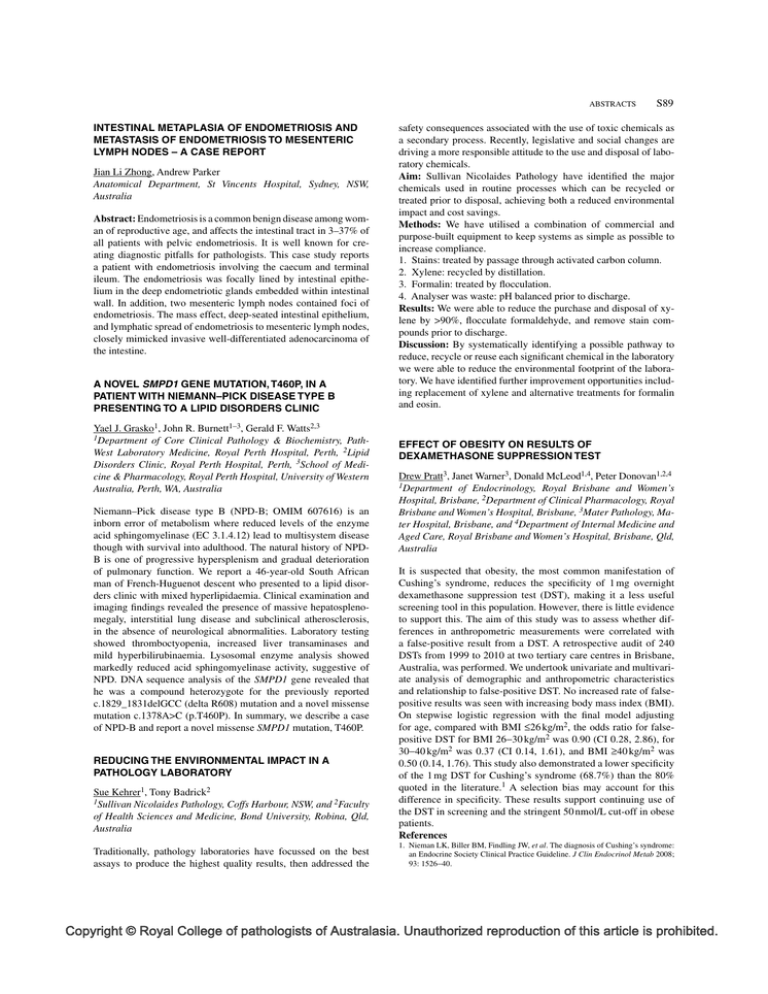S89
advertisement

ABSTRACTS INTESTINAL METAPLASIA OF ENDOMETRIOSIS AND METASTASIS OF ENDOMETRIOSIS TO MESENTERIC LYMPH NODES – A CASE REPORT Jian Li Zhong, Andrew Parker Anatomical Department, St Vincents Hospital, Sydney, NSW, Australia Abstract: Endometriosis is a common benign disease among woman of reproductive age, and affects the intestinal tract in 3–37% of all patients with pelvic endometriosis. It is well known for creating diagnostic pitfalls for pathologists. This case study reports a patient with endometriosis involving the caecum and terminal ileum. The endometriosis was focally lined by intestinal epithelium in the deep endometriotic glands embedded within intestinal wall. In addition, two mesenteric lymph nodes contained foci of endometriosis. The mass effect, deep-seated intestinal epithelium, and lymphatic spread of endometriosis to mesenteric lymph nodes, closely mimicked invasive well-differentiated adenocarcinoma of the intestine. A NOVEL SMPD1 GENE MUTATION, T460P, IN A PATIENT WITH NIEMANN–PICK DISEASE TYPE B PRESENTING TO A LIPID DISORDERS CLINIC Yael J. Grasko1, John R. Burnett1–3, Gerald F. Watts2,3 of Core Clinical Pathology & Biochemistry, PathWest Laboratory Medicine, Royal Perth Hospital, Perth, 2Lipid Disorders Clinic, Royal Perth Hospital, Perth, 3School of Medicine & Pharmacology, Royal Perth Hospital, University of Western Australia, Perth, WA, Australia 1Department Niemann–Pick disease type B (NPD-B; OMIM 607616) is an inborn error of metabolism where reduced levels of the enzyme acid sphingomyelinase (EC 3.1.4.12) lead to multisystem disease though with survival into adulthood. The natural history of NPDB is one of progressive hypersplenism and gradual deterioration of pulmonary function. We report a 46-year-old South African man of French-Huguenot descent who presented to a lipid disorders clinic with mixed hyperlipidaemia. Clinical examination and imaging findings revealed the presence of massive hepatosplenomegaly, interstitial lung disease and subclinical atherosclerosis, in the absence of neurological abnormalities. Laboratory testing showed thromboctyopenia, increased liver transaminases and mild hyperbilirubinaemia. Lysosomal enzyme analysis showed markedly reduced acid sphingomyelinase activity, suggestive of NPD. DNA sequence analysis of the SMPD1 gene revealed that he was a compound heterozygote for the previously reported c.1829_1831delGCC (delta R608) mutation and a novel missense mutation c.1378A>C (p.T460P). In summary, we describe a case of NPD-B and report a novel missense SMPD1 mutation, T460P. REDUCING THE ENVIRONMENTAL IMPACT IN A PATHOLOGY LABORATORY Sue Kehrer1, Tony Badrick2 1Sullivan Nicolaides Pathology, Coffs Harbour, NSW, and 2Faculty of Health Sciences and Medicine, Bond University, Robina, Qld, Australia Traditionally, pathology laboratories have focussed on the best assays to produce the highest quality results, then addressed the S89 safety consequences associated with the use of toxic chemicals as a secondary process. Recently, legislative and social changes are driving a more responsible attitude to the use and disposal of laboratory chemicals. Aim: Sullivan Nicolaides Pathology have identified the major chemicals used in routine processes which can be recycled or treated prior to disposal, achieving both a reduced environmental impact and cost savings. Methods: We have utilised a combination of commercial and purpose-built equipment to keep systems as simple as possible to increase compliance. 1. Stains: treated by passage through activated carbon column. 2. Xylene: recycled by distillation. 3. Formalin: treated by flocculation. 4. Analyser was waste: pH balanced prior to discharge. Results: We were able to reduce the purchase and disposal of xylene by >90%, flocculate formaldehyde, and remove stain compounds prior to discharge. Discussion: By systematically identifying a possible pathway to reduce, recycle or reuse each significant chemical in the laboratory we were able to reduce the environmental footprint of the laboratory. We have identified further improvement opportunities including replacement of xylene and alternative treatments for formalin and eosin. EFFECT OF OBESITY ON RESULTS OF DEXAMETHASONE SUPPRESSION TEST Drew Pratt3, Janet Warner3, Donald McLeod1,4, Peter Donovan1,2,4 of Endocrinology, Royal Brisbane and Women’s Hospital, Brisbane, 2Department of Clinical Pharmacology, Royal Brisbane and Women’s Hospital, Brisbane, 3Mater Pathology, Mater Hospital, Brisbane, and 4Department of Internal Medicine and Aged Care, Royal Brisbane and Women’s Hospital, Brisbane, Qld, Australia 1Department It is suspected that obesity, the most common manifestation of Cushing’s syndrome, reduces the specificity of 1 mg overnight dexamethasone suppression test (DST), making it a less useful screening tool in this population. However, there is little evidence to support this. The aim of this study was to assess whether differences in anthropometric measurements were correlated with a false-positive result from a DST. A retrospective audit of 240 DSTs from 1999 to 2010 at two tertiary care centres in Brisbane, Australia, was performed. We undertook univariate and multivariate analysis of demographic and anthropometric characteristics and relationship to false-positive DST. No increased rate of falsepositive results was seen with increasing body mass index (BMI). On stepwise logistic regression with the final model adjusting for age, compared with BMI ≤26 kg/m2, the odds ratio for falsepositive DST for BMI 26−30 kg/m2 was 0.90 (CI 0.28, 2.86), for 30−40 kg/m2 was 0.37 (CI 0.14, 1.61), and BMI ≥40 kg/m2 was 0.50 (0.14, 1.76). This study also demonstrated a lower specificity of the 1 mg DST for Cushing’s syndrome (68.7%) than the 80% quoted in the literature.1 A selection bias may account for this difference in specificity. These results support continuing use of the DST in screening and the stringent 50 nmol/L cut-off in obese patients. References 1. Nieman LK, Biller BM, Findling JW, et al. The diagnosis of Cushing’s syndrome: an Endocrine Society Clinical Practice Guideline. J Clin Endocrinol Metab 2008; 93: 1526−40. Copyright © Royal College of pathologists of Australasia. Unauthorized reproduction of this article is prohibited.




